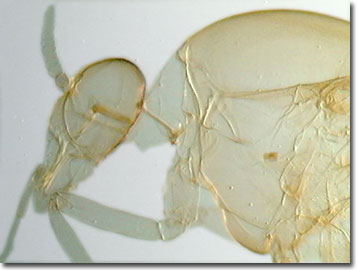Oblique Digital Image Gallery
Simulium Species
The bane of moose and man, blackflies of the genus Simulium (order Diptera:family Simuliidae) are known to have made many humans and animals jump in nearby lakes up to their necks to avoid blood-letting bites. As a cruel irony to outdoors aficionados, only the most pristine, well-oxygenated streams grow large hordes of blackflies, and not those tainted with pollution. From the remote New York Adirondack Mountains to the roaring streams of New Zealand, Simulium is the most diverse blackfly genus with almost 1,200 species arranged in 42 subgenera throughout all the zoogeographical regions of the world. While despised by humans and avoided as much as possible by ungulates, blackflies supply ample protein biomass to hungry stream fishes and flying predators, such as adult dragonflies and many birds.

The life history of a blackfly provides clues towards their control. As an aquatic insect, the larval blackfly is almost perfectly adapted for high gradient, well-oxygenated streams. Avoiding the competition and lower dissolved oxygen concentrations of the slower backwaters, blackfly larvae cling to submerged rocks with an anchoring patch of spun silk and a highly modified posterior circlet of hooks. These adaptations allow them to attach in roaring currents and even waterfalls, without falling prey to the enormous force of the passing waters. As filter feeders, blackfly larvae capture bacteria and diatoms with feeding nets constructed from a pair of cephalic fans and a sticky secretion produced by the cibarial glands. Thus, blackfly larvae use the water's strong current to deliver food at a rapid rate. Some species of Simulium graze the substrate for nourishment instead of filter feeding.
Blackflies spin cocoons in which they pupate underwater. As the nonfeeding pupa develops, it becomes progressively darker. Eventually, the pupal skin splits and the adult floats to the water surface on an air bubble and immediately takes flight. Large swarms of adults form near the natal streams, but can drift up to 200 meters from the breeding site. Male and female flies feed on plant nectar, which they store in the crop. Only females are bloodsuckers, with the blood passing directly to the midgut. There appears to be some specialization in the shape of the leg claws that distinguishes ornithophilic blackflies from mammalophilic species. Human and livestock fatalities attributable to female feeding frenzies are documented, and internationally, significant human diseases such as river blindness are associated with blackfly bites.
Control methods other than insecticides include the modification of stream flows, parasitic bacterium Bacillus thuringiensis, and coating the water with surfactants or other substances that reduce dissolved oxygen concentrations. The benefits for controlling blackfly populations need to be balanced against ecological costs to the stream and riparian communities.
Contributing Authors
Cynthia D. Kelly, Thomas J. Fellers and Michael W. Davidson - National High Magnetic Field Laboratory, 1800 East Paul Dirac Dr., The Florida State University, Tallahassee, Florida, 32310.
BACK TO THE OBLIQUE IMAGE GALLERY
BACK TO THE DIGITAL IMAGE GALLERIES
Questions or comments? Send us an email.
© 1995-2025 by Michael W. Davidson and The Florida State University. All Rights Reserved. No images, graphics, software, scripts, or applets may be reproduced or used in any manner without permission from the copyright holders. Use of this website means you agree to all of the Legal Terms and Conditions set forth by the owners.
This website is maintained by our
Graphics & Web Programming Team
in collaboration with Optical Microscopy at the
National High Magnetic Field Laboratory.
Last Modification Friday, Nov 13, 2015 at 01:19 PM
Access Count Since September 17, 2002: 11985
Visit the website of our partner in introductory microscopy education:
|
|
